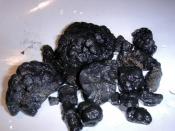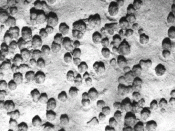Manganese nodules are small, dark, potato-shaped mixtures of different minerals, containing sources of useful metals such as manganese, iron, copper, nickel, lead, zinc and cobalt. The nodules are formed by about 24% of manganese, 15% iron, 1.5% of nickel and smaller abundances of the other elements. Manganese nodules are found in large quantities in the sea-beds of oceans proximate to the regions of Russia, Brazil, Australia, Cook Islands, South Africa, Gabon, India and the Solomon Islands. It is generally found under depths of 2,750 to 4,500 meter of water, very often near tectonic plate boundaries, as it is formed from risen lava solidified between diverging oceanic plates. Therefore, it has a very small growth rate, millimetres per million years. They're usually located a few thousand kilometres off the closest continental shores. In the early 1970's, undersea manganese nodules were considered gold mines. Since the legal aspects of manganese weren't clear as the nodules were outside most EEZ 's, the UN created the International Seabed Authority, located in Kingston, Jamaica, to regulate these issues.
This organization has passed down the law which states that the shoreline of the closest country to the resources has legal rights over it.
Manganese was recognised as an element by Bergman Scheele and others and was isolated by J.G. Grahn in 1774 in Stockholm, Sweden. Manganese is a transition metal that resembles iron; it is greyish white coloured, but it's harder and very brittle. It is also chemically reactive, as it decomposes water slowly. Its atomic number is 25, atomic weight is 54.938 and atomic symbol is Mn. Its electron configuration is 2-8-13-2 and it has melting and boiling points of 1245úC and 1962úC. Manganese plays a vital biological role for humans, as it is essential for healthy skin and strong bone and cartilage formation.


